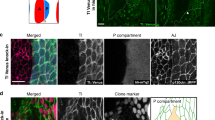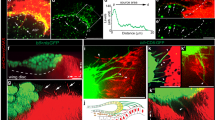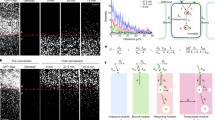Abstract
Cell recognition and selective adhesion may be important in pattern formation; such processes in Drosophila melanogaster could be responsible for the maintenance of segment boundaries1, the morphogenesis of metamorphosing imaginal disks2, and the paths of axon outgrowth during neurogenesis3. As cells from different imaginal disks of Drosophila are able to recognize and sort out from one another4,5, we decided to investigate whether these larval cells could recognize and bind to the epidermis of intact embryos. We report here that imaginal disk cells bind preferentially to the epidermis of the embryonic segments from which they are derived: thoracic disk cells to thoracic segments and genital disk cells to abdominal segments. Furthermore, thoracic disk cells recognize and bind, without preference, to all segments of the homoeotic mutant Df(3R)P9 (ref. 6). We conclude, therefore, that cells of the same segmental origin have similar recognition properties at different developmental stages.
This is a preview of subscription content, access via your institution
Access options
Subscribe to this journal
Receive 51 print issues and online access
$199.00 per year
only $3.90 per issue
Buy this article
- Purchase on Springer Link
- Instant access to full article PDF
Prices may be subject to local taxes which are calculated during checkout
Similar content being viewed by others
References
Crick, F. H. C. & Lawrence, P. Science 189, 340–347 (1975).
Poodry, C. & Schneiderman, H. Wilhelm Roux Arch. dev. Biol. 168, 1–9 (1971).
Thomas, J. B., Bastiani, M. J., Bate, M. & Goodman, C. S. Nature 310, 203–207 (1984).
Fehon, R. G. & Schubiger, G. Devl Biol. (in the press).
Garcia-Bellido, A. Devl Biol 14, 278–306 (1966).
Lewis, E. B. Nature 276, 565–570 (1978).
Schneider, I. J. exp. Zool. 156, 91–104 (1964).
Ephrussi, B. & Beadle, G. W. Am. Nat. 70, 218–225 (1936).
Sokal, R. R. & Rohlf, F. J. Biometry (Freeman, San Francisco, 1969).
Dübendorfer, K. & Nöthiger, R. Wilhelm Roux Arch. dev. Biol. 191, 42–55 (1982).
Hayes, P. H. et al. Proc. natn. Acad. Sci. U.S.A. 81, 545–549 (1984).
Gauger, A. & Schubiger, G. Drosoph. Inf. Serv. 60, 108–109 (1984).
Morata, G. & Kerridge, S. Nature 290, 778–783 (1981).
Struhl, G. Proc. natn. Acad. Sci. U.S.A. 79, 7380–7384 (1982).
Madhavan, M. M. & Schneiderman, H. A. Wilhelm Roux Arch. dev. Biol. 183, 269–305 (1977).
Simcox, A. A. & Sang, J. H. Devl Biol. 97, 212–221 (1983).
Author information
Authors and Affiliations
Rights and permissions
About this article
Cite this article
Gauger, A., Fehon, R. & Schubiger, G. Preferential binding of imaginal disk cells to embryonic segments of Drosophila. Nature 313, 395–397 (1985). https://doi.org/10.1038/313395a0
Received:
Accepted:
Issue Date:
DOI: https://doi.org/10.1038/313395a0
This article is cited by
-
Calcium-dependent adhesion of Drosophila embryonic cells
Roux's Archives of Developmental Biology (1990)
Comments
By submitting a comment you agree to abide by our Terms and Community Guidelines. If you find something abusive or that does not comply with our terms or guidelines please flag it as inappropriate.



